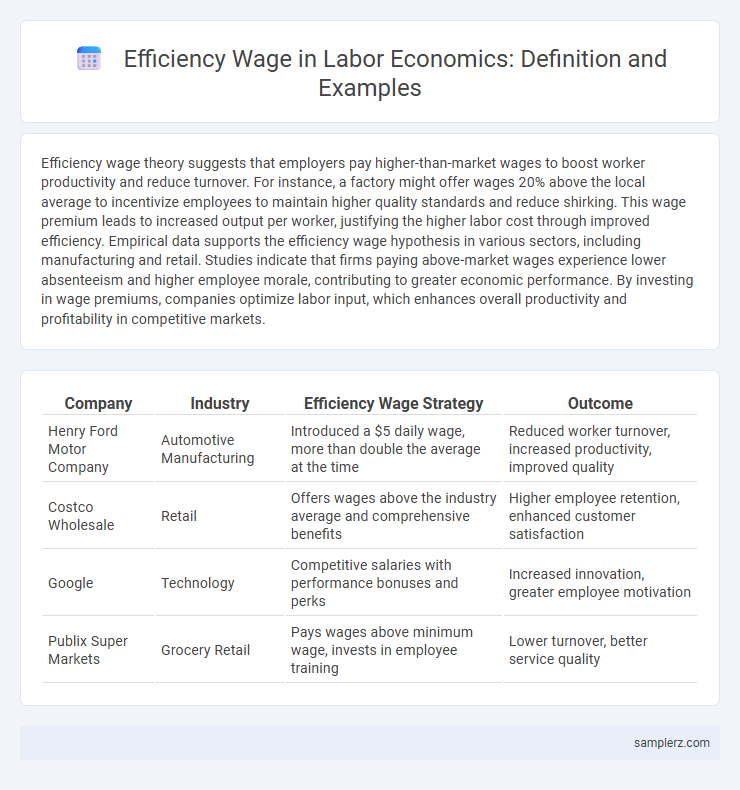Efficiency wage theory suggests that employers pay higher-than-market wages to boost worker productivity and reduce turnover. For instance, a factory might offer wages 20% above the local average to incentivize employees to maintain higher quality standards and reduce shirking. This wage premium leads to increased output per worker, justifying the higher labor cost through improved efficiency. Empirical data supports the efficiency wage hypothesis in various sectors, including manufacturing and retail. Studies indicate that firms paying above-market wages experience lower absenteeism and higher employee morale, contributing to greater economic performance. By investing in wage premiums, companies optimize labor input, which enhances overall productivity and profitability in competitive markets.
Table of Comparison
| Company | Industry | Efficiency Wage Strategy | Outcome |
|---|---|---|---|
| Henry Ford Motor Company | Automotive Manufacturing | Introduced a $5 daily wage, more than double the average at the time | Reduced worker turnover, increased productivity, improved quality |
| Costco Wholesale | Retail | Offers wages above the industry average and comprehensive benefits | Higher employee retention, enhanced customer satisfaction |
| Technology | Competitive salaries with performance bonuses and perks | Increased innovation, greater employee motivation | |
| Publix Super Markets | Grocery Retail | Pays wages above minimum wage, invests in employee training | Lower turnover, better service quality |
Understanding Efficiency Wages in Economic Theory
Efficiency wages are higher-than-market wages paid by employers to boost worker productivity and reduce turnover, which in turn can lead to increased overall economic efficiency. Economic theory highlights how paying efficiency wages helps alleviate issues like shirking and adverse selection by aligning worker incentives with firm goals. This concept explains wage rigidity in labor markets and contributes to understanding unemployment dynamics and wage dispersion.
Historical Cases of Efficiency Wage Implementation
Efficiency wage theory was historically applied in the 1930s by Henry Ford, who famously doubled workers' pay to $5 per day, resulting in increased productivity and reduced turnover in his factories. In the 1980s, Japanese manufacturing firms implemented efficiency wages to boost worker motivation and quality control, contributing to their global competitive advantage. These historical cases underscore how paying above-market wages can enhance labor efficiency and firm profitability.
Efficiency Wage Practices in the Manufacturing Sector
Efficiency wage practices in the manufacturing sector involve paying workers above the market-clearing wage to boost productivity and reduce turnover. This strategy leads to higher worker morale, decreased shirking, and improved overall output quality. Companies implementing efficiency wages often see a significant reduction in recruitment and training costs due to increased employee retention.
How Tech Companies Apply Efficiency Wage Models
Tech companies implement efficiency wage models by offering salaries above market rates to attract and retain top talent, reducing turnover costs and enhancing productivity. Firms like Google and Apple invest heavily in competitive compensation packages, including bonuses and stock options, to incentivize employee performance and foster innovation. This strategy minimizes shirking and aligns worker effort with company goals, leading to higher operational efficiency.
Retail Industry: Examples of Efficiency Wage Benefits
Efficiency wage theory in the retail industry demonstrates increased employee productivity and reduced turnover by paying wages above the market rate. Higher wages motivate retail workers to improve customer service, leading to increased sales and enhanced brand loyalty. Retailers benefit from lower recruitment costs and reduced absenteeism, contributing to overall operational efficiency and profitability.
Efficiency Wages and Worker Productivity: Real-World Evidence
Efficiency wage theory suggests that paying workers above the market-clearing wage increases productivity by boosting morale and reducing turnover. Research by Edin and Topel (1997) demonstrates that firms offering higher wages experience lower absenteeism and improved output per worker. Empirical studies in sectors like manufacturing and services confirm that efficiency wages lead to enhanced worker effort and organizational performance.
Impact of Efficiency Wages on Employee Turnover Rates
Efficiency wages, which pay employees above the market equilibrium, significantly reduce employee turnover rates by increasing job satisfaction and loyalty. Higher wages discourage workers from seeking alternative employment, lowering recruitment and training costs for employers. Studies indicate firms adopting efficiency wage policies experience turnover rate reductions by up to 20%, enhancing overall workforce stability.
Regional Case Studies: Efficiency Wages in Developing Economies
In developing economies, efficiency wage models demonstrate significant productivity gains by paying workers above the market-clearing wage, reducing turnover and absenteeism. Studies in regions such as South Asia and Sub-Saharan Africa reveal that firms offering higher wages experience increased worker effort and improved overall output. Empirical evidence from countries like India and Kenya highlights the role of efficiency wages in mitigating labor market inefficiencies and enhancing firm competitiveness.
Efficiency Wages and Their Role in Reducing Shirking
Efficiency wages are higher-than-market wages paid by employers to increase worker productivity and reduce shirking by enhancing job satisfaction and worker loyalty. These wages create a financial incentive for employees to avoid shirking, as the cost of losing a well-paying job exceeds the benefits of reduced effort. Empirical studies show that efficiency wages can lead to lower turnover rates and increased overall efficiency in the labor market.
Policy Implications: Lessons from Efficiency Wage Examples
Efficiency wage theory suggests that paying workers above-market wages can reduce turnover, increase productivity, and improve overall firm performance. Policy implications indicate that minimum wage policies designed with efficiency wage principles in mind may enhance labor market stability and reduce unemployment rates. Empirical studies from countries like Sweden and Germany reveal that firms adopting efficiency wage practices experience higher employee morale and lower training costs, informing wage policy reforms aimed at boosting economic growth.

example of efficiency wage in labor Infographic
 samplerz.com
samplerz.com